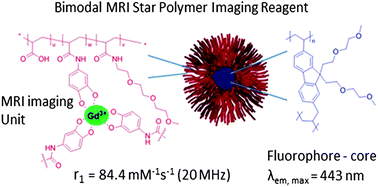High relaxivity MRI imaging reagents from bimodal star polymers†
Abstract
Star

* Corresponding authors
a
Department of Chemistry, Institute of Nanoscale Science and Engineering, Vanderbilt Institute of Chemical Biology, Vanderbilt University, 7619 Stevenson Center, Nashville, TN, USA
E-mail:
eva.harth@vanderbilt.edu
b Lipscomb University, College of Pharmacy, Nashville, TN, USA
c Vanderbilt University Institute of Imaging Science, 1161 21st Avenue South, Medical Center North, AA-1105, Nashville, TN, USA
Star

 Please wait while we load your content...
Something went wrong. Try again?
Please wait while we load your content...
Something went wrong. Try again?
C. T. Adkins, J. N. Dobish, C. S. Brown, B. Mayrsohn, S. K. Hamilton, F. Udoji, K. Radford, T. E. Yankeelov, J. C. Gore and E. Harth, Polym. Chem., 2012, 3, 390 DOI: 10.1039/C1PY00474C
To request permission to reproduce material from this article, please go to the Copyright Clearance Center request page.
If you are an author contributing to an RSC publication, you do not need to request permission provided correct acknowledgement is given.
If you are the author of this article, you do not need to request permission to reproduce figures and diagrams provided correct acknowledgement is given. If you want to reproduce the whole article in a third-party publication (excluding your thesis/dissertation for which permission is not required) please go to the Copyright Clearance Center request page.
Read more about how to correctly acknowledge RSC content.
 Fetching data from CrossRef.
Fetching data from CrossRef.
This may take some time to load.
Loading related content
